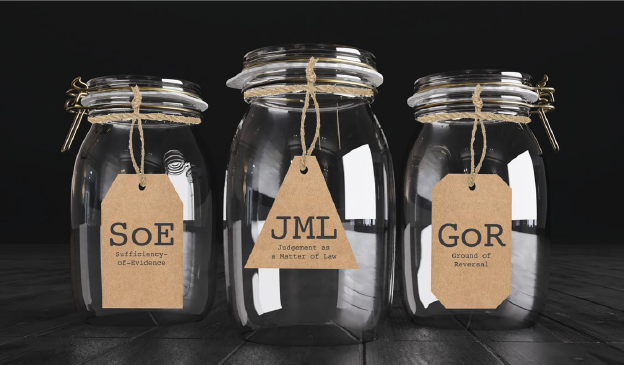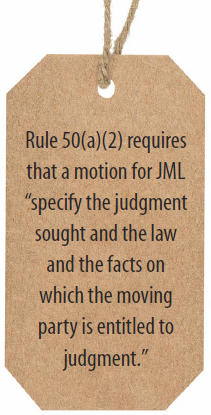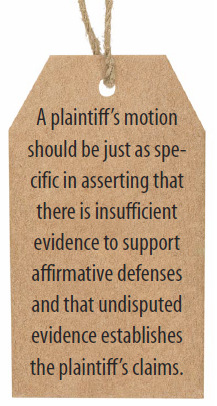Winter 2025

Issues must be raised in the trial court to be considered on appeal. In cases tried to a jury, parties must present certain issues in motions for judgment as a matter of law or for new trial, and under some circumstances in non-jury cases, parties must raise issues in a motion for new trial or other post-judgment motion, to preserve them for appeal.
MOTIONS IN CASES TRIED TO A JURY
Judgment as a matter of law under Rule 50
Ala. R. Civ. P. 50 provides for trial and post-trial motions for judgment as a matter of law ("JML"). Rule 50(a)(1) states that "[i]f during a trial by jury a party has been fully heard on an issue and there is no legally sufficient evidentiary basis for a reasonable jury to find for that party on that issue," the court "may determine the issue against that party and may grant a motion for [JML] against that party with respect to a claim or defense that cannot under the controlling law be maintained or defeated without a favorable finding on that issue." Rule 50(b) provides that "[w]henever a motion for [JML] made at the close of all the evidence is denied or for any reason is not granted," the motion "may be renewed by service and filing not later than thirty (30) days after entry of judgment."
Before an amendment to Rule 50 in 1995, the motion under Rule 50(a) was known as one for "directed verdict," and the post-trial motion under Rule 50(b) was known as one for "judgment notwithstanding the verdict" or "judgment non obstante veredicto" ("JNOV"). The pre-amendment case law "remain[s] valid except for the references to obsolete terminology," and thus applies to motions for JML.1
Function of, and standard for granting, motion for JML
A defendant's motion for JML challenges the sufficiency of the evidence to create a question of fact for the jury on the plaintiff's claims. A plaintiff's motion for JML does the same with respect to the defendant's affirmative defenses.2 As Rule 50(a)(1) states, the movant is entitled to JML if there is "no legally sufficient evidentiary basis for a reasonable jury to find for" the nonmovant on a claim or affirmative defense.
Ala. Code § 12-21-12 provides that "substantial evidence shall be required to submit an issue of fact to the trier of the facts," and defines "substantial evidence" as "evidence of such quality and weight that reasonable and fair-minded persons in the exercise of impartial judgment might reach different conclusions as to the existence of the fact sought to be proven."3 Thus, to avoid JML, the "non-movant must present 'substantial evidence' supporting each element of his cause of action or [affirmative] defense."4 The court views the evidence in the light most favorable to the nonmovant and makes an objective determination whether the nonmovant has presented substantial evidence, regardless of countervailing evidence.5
A movant can also obtain JML on the basis that substantial undisputed evidence establishes the movant's own affirmative defense or claim for relief.6
Two-step procedure for preserving entitlement to JML
To preserve a right to JML, parties must comply with a "two-step procedure."7 First, a party must move for JML under Rule 50(a) at the close of all the evidence (or at least "before submission of the case to the jury"8 ) on the ground that there is insufficient evidence to support the nonmovant's claim or affirmative defense.9 Second, if the jury renders a verdict against the party who moved for JML, that party must file a renewed motion under Rule 50(b) within 30 days of judgment, asserting the same grounds of evidentiary insufficiency.10 The renewed motion gives the trial court a "second look at the 'insufficiency' ground as a prerequisite for appellate review[.]"11
Both motions are required.12 When no motion is filed at the close of all the evidence, there is no motion that can be renewed, and evidentiary insufficiency cannot be raised in a post-judgment motion for JML.13 When a motion is filed at the close of all the evidence but is not renewed, the trial court has no post-judgment opportunity to "revisit" its earlier denial of JML, as is necessary to preserve the sufficiency-of-evidence issue.14
Parties must also comply with the two-step procedure to preserve a right to JML on the ground that substantial, undisputed evidence establishes a party's own affirmative defense or claim for relief.15

Contents of motion for JML
Rule 50(a)(2) requires that a motion for JML "specify the judgment sought and the law and the facts on which the moving party is entitled to judgment." The Alabama Supreme Court has stated that "appellate review is preserved by a Rule 50(a) motion 'alleg[ing] a lack of evidence' as to each of the plaintiff's claims."16 The court has also stated that the motion should identify "the count which is not supported by evidence and detail[] with specificity the grounds upon which the particular count is not supported by the evidence."17
Motions that lack specificity - such as one merely stating that "the evidence did not establish liability" - are known as "general" motions and "in some instances, [are] not . . . sufficient to invoke appellate review."18 A "general" motion "can only go to the case in its entirety, and not to individual subdivisions; and, to preserve individual issues, a motion must be made for [JML] on each of the individual issues."19 For example, a defendant's motion asserting that the plaintiff "failed to carry [his] burden of proof with the evidence submitted," was held inadequate "to preserve for appeal the argument that [the plaintiff] was contributorily negligent as a matter of law."20 Specificity as to parties is also important - a defendant's motion averring that two plaintiffs "failed to introduce substantial evidence to prove . . . their claim," was found inadequate to preserve an argument that each plaintiff had a separate claim and that one of them "failed to prove its [claim]."21
Because a post-judgment motion under Rule 50(b) "is really just a renewal of" the earlier motion under Rule 50(a),22 a party cannot file a general motion at the close of all the evidence and expect to file a more specific motion after judgment. A post-judgment motion, "based on the 'insufficiency of the evidence,' is improper" to the extent the party did not move for JML "on the same ground at the close of all the evidence."23 Subject to an exception relating to punitive damages (discussed hereinafter), a court cannot consider new grounds of evidentiary insufficiency in a post-judgment motion for JML.24
It is therefore paramount that a party's motion for JML at the close of all the evidence be specific and include all possible grounds of evidentiary insufficiency. To be thorough, defendants' motions should assert that there is insufficient evidence to support each count, each claim, each element of each claim, each material factual allegation, and each item of damages as to which the defendant contends the plaintiff lacks substantial evidence.25 Defendants' motions should also aver that the evidence establishes each affirmative defense that the defendant contends is supported by substantial, undisputed evidence.26 If there is more than one plaintiff, each with his or her own claims, the defendant's motion should assert all grounds as to each plaintiff separately and severally.27 The motion should also cite supporting legal authority.28 A plaintiff's motion should be just as specific in asserting that there is insufficient evidence to support affirmative defenses and that undisputed evidence establishes the plaintiff's claims.

Rule 50(b) states that "[a] motion for a new trial under Rule 59 may be joined with a renewal of the motion for [JML], or a new trial may be requested in the alternative." Hence, a party filing a renewed motion should consider whether such joinder or alternative request is appropriate.
Good-count/bad-count rule
When a trial court submits several claims to the jury and the jury returns a general verdict for the plaintiff, it is usually "impossible to know on which of the multiple theories the jury based its verdict."29 If the court submits "good" claims (i.e., claims supported by substantial evidence) and "bad" claims (claims that are not supported by substantial evidence) to the jury, the "good-count/bad-count rule" applies. Under this rule, whether a judgment based on a general verdict for the plaintiff will withstand a defendant's renewed motion for JML depends on the specificity of the defendant's motion at the close of all the evidence and of the renewed motion.
If the defendant, at the close of all the evidence, files a "general" motion for JML going to the case as a whole, rather than a motion specifically challenging each claim, separately and individually, that the defendant contends is not supported by substantial evidence, the trial court commits no error by denying the motion if any claim is "good."30 The defendant's renewed motion must also be denied if any claim was "good."31 The court "will presume that the [general] verdict was returned on [a] 'good count.'"32
If, however, the defendant, at the close of all the evidence, files a motion for JML that specifically challenges each claim, separately and individually, that the defendant contends is not supported by substantial evidence, the trial court errs in denying the motion as to any "bad" claims.33 If the defendant files a renewed motion for JML, again specifically contesting evidentiary sufficiency as to each claim, the court will not presume that the general verdict was based on a "good"...
